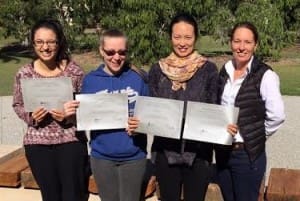
LBN’s Dr Sarah-Jane Wilson, far right, with UQ School of Veterinary Science students, from left, Sanjana Maruvada, Eloise Rimon and Najin Kim. They were highly commended for their livestock biosecurity case study.
VETERINARY students are being faced with realistic livestock disease and animal welfare scenarios as part of the University of Queensland’s unique on-farm biosecurity planning module.
On-farm biosecurity planning has been included for the first time in the university’s School of Veterinary Science course curriculum to improve outcomes for farms and animals across the country.
In an effort to equip the next generation of veterinarians with the knowledge they need, Livestock Biosecurity Network (LBN) has teamed up with University of Queensland’s School of Veterinary Science (SVS) to include on-farm biosecurity planning in the third year veterinary curriculum.
Students face specific biosecurity scenarios
The university’s School of Veterinary Science course coordinator Dr David McNeill said Northern Australia LBN regional officer Dr Sarah-Jane Wilson helped the vet students undertake livestock case studies based on specific biosecurity scenarios.
“They had to read through the scenario of this particular producer and then take information from the broader LBN booklet and tailor-make it to that producer.
“They had to look at the producer’s circumstances and then suggest which biosecurity issues are likely to be the greatest risk to them.”
The students then produced a two-page “keep-it-simple” brochure for the theoretical producer that highlighted the most important biosecurity risks or “likely risk perspectives” and direct them to further information, Dr McNeill said.
“It was a learning exercise to try to push the students through the barrier.
“It helped them prioritise, pull out the really important issues and be succinct.”
Biosecurity planning considers entire farming system
Dr McNeill said biosecurity planning helped students realise the importance of taking the entire farming system into account when trying to manage disease and animal product safety risks.
“They must consider the system from the ground up and right along the food and fibre supply chain to the consumer that could be anywhere in the world.”
The students gained a better understanding of the breadth of biosecurity factors, the preventative perspective and the importance of maintaining a paper trail for traceback, he said.
“It teaches them that a lot of the biosecurity issues meld very nicely with the same issues that we have to focus on to maintain high production.
“So we teach them that there are win-win situations out there,” he said.
“That it’s not just about solving this disease problem; it is about ‘if you attack this disease problem you can also improve your productivity’.”
Veterinary science at UQ looks at the ‘big picture’
Dr McNeill said veterinary science is not just about saving a diseased animal.
“That’s why we teach students to step back and look at the big picture of the enterprise, understanding how the regulatory requirements support the ongoing trade capacity of our livestock industries.”
The proactive approach to integrated student learning and real world issues places students in a prime position to advance as professionals of the future, he said. The course prepares students who will work with production animals in the future, whether on commercial enterprises or smaller hobby farms.
Vets maybe only biosecurity contact of small farmers
Dr Wilson said for many small and hobby farmers, the local vet may be the only person with biosecurity knowledge they ever come into contact with.
“For instance, many lifestyle farmers are not aware they need to register for a property identification code, even if they have just one head of livestock.
“We are assisting the students in understanding the mandatory elements of keeping livestock and exposing them to theoretical case studies that include real world biosecurity issues, to help prepare them for almost every eventuality.”
Dr Wilson says UQ’s training program will help to strengthen the livestock industry’s capacity to manage biosecurity risks and deal with emergencies, should they occur. Encouraging students to think more holistically about livestock systems also builds their confidence in helping their clients comply with biosecurity requirements, she said.
LBN is an industry initiative servicing all sectors of the sheep and cattle industries. It aims to improve the knowledge and understanding of animal health, welfare and biosecurity among key stakeholders, and works with government and industry partners to help protect livestock industries from emergency animal diseases.
To help protect their livelihood and income, producers are encouraged to complete the On-Farm Biosecurity Plan at www.lbn.org.au/farm-biosecurity-tools/on-farm-biosecurity-planning-tools/
To find out more about the Livestock Biosecurity Network, contact Northern Australia LBN Regional Officer Dr Sarah-Jane Wilson on 0437 725 877 or visit www.lbn.org.au
Sources: Livestock Biosecurity Network, University of Queensland.

HAVE YOUR SAY